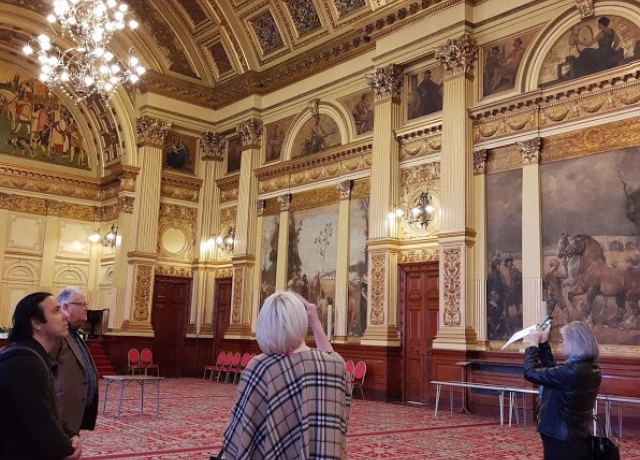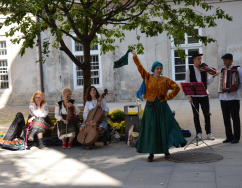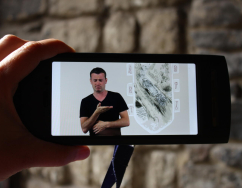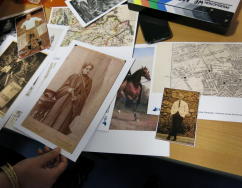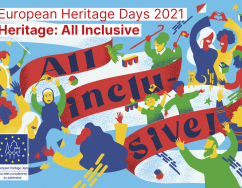Connecting Through Language
Connecting Through Language
Keep wording clear
European Heritage Days events are a fantastic way for visitors to learn about history and culture and discover different places, stories and traditions. Ensuring that the language in these events is accessible to new audiences is therefore very important. This is also particularly the case for people learning a new language or who have cognitive or learning differences. Everyone should feel welcome at European Heritage Days events, so organisers should aim to keep wording and phrasing clear and straightforward to make sure they encourage exploration of new topics and that no one is excluded by their literacy level.
Our Inclusive Events Toolkit provides some ideas for tailoring language to make it more accessible, such as writing in short sentences and assessing wording using online ‘readability’ checkers. Providing explanations for any acronyms or technical language used can also help make sure the content is understandable to wider audiences.
Provide translations
Migration and international diversity are topics very relevant to Heritage: All Inclusive. International communities are of course likely to use different first languages or use other languages at home. Creating translations or language-specific options while developing events can help support efforts to connect with these groups.
An example of this took place during Doors Open in Scotland in 2019. Organisers specifically wanted to reach out to the migrant and refugee community. Working alongside the Refugee Survival Trust and the Scottish Refugee Council, organisers identified Farsi as an important language for many refugees living in Glasgow, while help from the Sikorski Society highlighted a significant settled migrant community of Poles in the city. Volunteers from these organisations then helped translate scripts for tours of Glasgow City Chambers, learning how to deliver them from the English-language guides who also helped teach the route and features of the historic building. Reactions to the events was very positive, with one visitor reporting the tour helped them feel more included and gave them a sense of ownership of cultural heritage. Research during the project also indicated that Urdu and Punjabi are also frequently spoken in the area, and organisers are now hoping to incorporate these languages into even more ‘Tours in Translation’ events in the future.
Reflect people’s identity
Language is a key part of identity and self-expression. The careful choice of phrases and words is a simple but crucial way to respect diverse audiences and encourage inclusive participation.
An example provided in our Inclusive Events Toolkit is use of the word ‘queer’ to refer to the LGBTQI+ community. In the UK context, for example, while this word has historically been used in a negative way, more recently it has been reclaimed by different LGBTQI+ communities as a marker of shared identity and a word for describing LGBTQI+ culture. The word is now used a lot in heritage contexts. When it comes to group and individual identity, the Toolkit has some simple rules: “respect the language people choose to refer to themselves”, “be aware of language used in your context” and “if in doubt, ask”.
Address language barriers
Not all language is verbal, and sign language and braille can help widen the audience of heritage events. An innovative example of a non-verbal language event highlighted in our All Inclusive Brochure is the ‘Chuuut Party’ (Shhh Party) in Belgium, which took place during European Heritage Days in 2018. Created through a collaboration of the Patrimoine à Roulettes and the local D/deaf community in the Brussels Capital Region, a special tour of the iconic Art Nouveau Solvay Library was organised. Hearing and non-hearing guides were paired and showed visitors around the site in a completely silent, but interactive experience. Visitors weren’t told who could speak or hear, giving everyone an equal platform to communicate through facial expressions and drawing. The concept proved very popular, and organisers intend to repeat the event.
Another previous event which addressed language barriers was the Monuments of History project in Poland. Taking place in 2018, the project aimed to improve accessibility to the country’s protected cultural monuments for blind and partially sighted people. Undertaken by the De Facto Association (Płock, central Poland), the project also aimed to raise public awareness of the limited access to heritage for blind people, as well as engage with young volunteers who were trained in producing audio descriptions. Initially audio and braille transcriptions were produced for 91 monuments including the Shipyard in Gdańsk, the Przemyśl Fortress and the Kościuszko Mound in Kraków. Over 1,100 blind people were sent packs containing the materials, and the project also produced 24 panels which described 12 of the monuments in-situ through tactile signage. The project continued into 2019 with the ‘Touch the Heritage’ project receiving funding from the National Heritage Board of Poland Together for Heritage initiative which increased the audio descriptions available to a further 14 monuments.
Discover more inspiration, ideas and tips for inclusive events in our Toolkit and Brochure, both available to download from the publications section of the European Heritage Days website.
